TypeScript函数和类
一颗冰淇淋 人气:0函数
以下声明了一个函数类型,通过type来定义类型别名,void 表示没有返回值
type fnType = () => void;
作为参数
函数可以作为参数,传递到另一个函数中
type fnType = () => void;
function foo(fn: fnType) {
fn();
}
function bar() {
console.log("bar");
}
foo(bar); // bar
与js代码不同的点在于传入的参数需要定义类型注解
定义函数
定义函数的时候,需要给入参指定类型注解,返回值如果可以自行推导出来,也可以不写,如 add 和 minus 函数,但是作为参数时,是必须要写的,如 calc 函数中的入参 fn
function add(num1: number, num2: number): number {
return num1 + num2;
}
function minus(num1: number, num2: number): number {
return num1 - num2;
}
function calc(
num1: number,
num2: number,
fn: (num1: number, num2: number) => void
) {
console.log(fn(num1, num2));
}
calc(30, 20, add); // 50
calc(30, 20, minus); // 10
函数参数的类型
ts中函数会规定参数的类型和个数,当个数不确定时,可以使用可选类型、剩余参数、默认值
可选类型
可选类型相当于该定义的类型和undefined的联合类型,所以参数有三种选择、传入该类型、不传或者undefined
function foo(x: number, y?: number) {
console.log(x, y);
}
foo(1, 2); // 1 2
foo(3); // 3 undefined
foo(4, undefined); // 4 undefined
参数默认值
参数设置了默认值就使之称为了可选类型,不过有默认值的参数最好放在必传参数后面
function baz(x: number = 20, y: number) {
console.log(x, y);
}
baz(10, 20); // 10 20
baz(undefined, 20); // 20 20
剩余参数
剩余参数要放在必传参数之后
function sum(num: number, ...args: number[]) {
console.log(num, args);
}
sum(10); // 10 []
sum(10, 20); // 10 [20]
sum(10, 20, 30); // 10 [20, 30]
this的默认推导
在对象的方法中定义的this,ts是可以自动推导的,但是独立函数中的this,是推导不出来的。
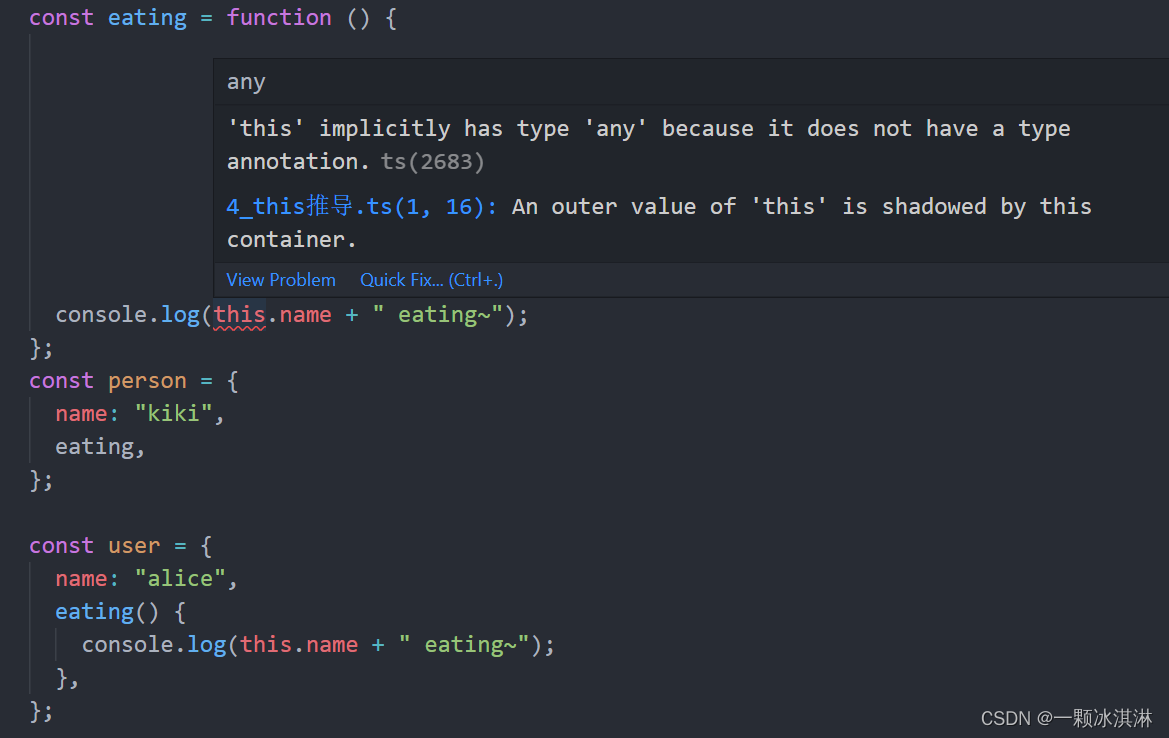
必须要在独立函数中定义this的类型
type ThisType = { name: string };
const eating = function (this: ThisType) {
console.log(this.name + " eating~");
};
const person = {
name: "kiki",
eating,
};
person.eating()
函数重载
函数重载指的是函数名相同,参数个数或者类型不同,所定义的多个处理方法。
比如需要对字符串拼接或者数字求和操作,虽然我们知道 + 号可以用在字符串和数字上,但是在类型检测严格的ts代码中,这样写编译是不通过的,需要使用【类型缩小】,缩小类型的判断,再进行处理。
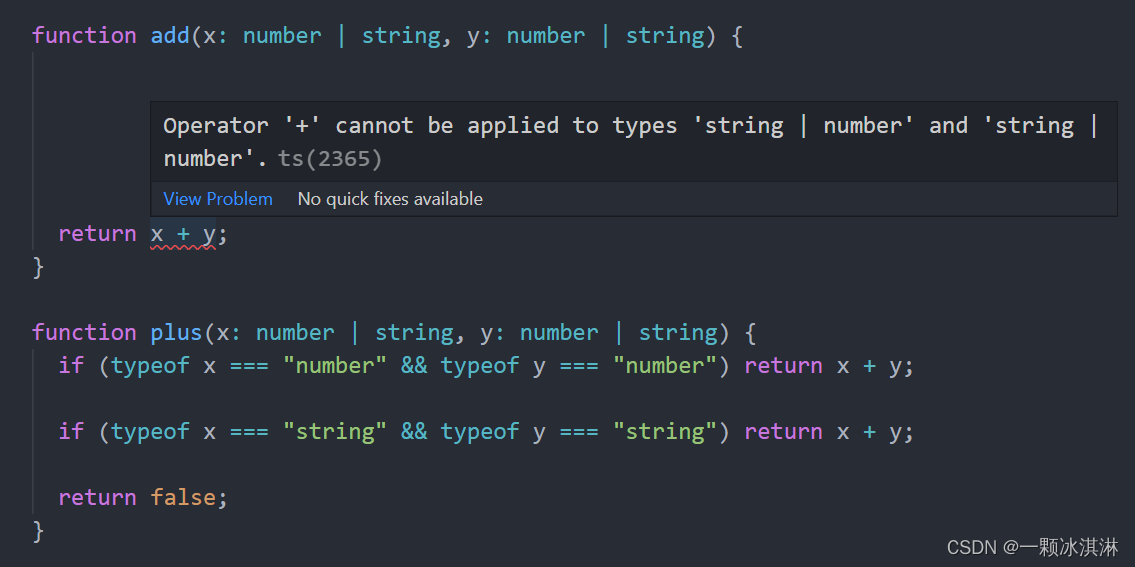
通过联合类型,参数组合的可能性越多,需要越多的if语句来进行判断,并且函数的返回值类型也是未知的,在这种情况下可以使用【函数重载】
在ts中,定义函数名和参数类型的重载函数,再通过实现函数来定义具体实现。 会根据数据类型在重载函数中调用,再执行实现函数的代码。
function add(x: number, y: number): number;
function add(x: string, y: string): string;
function add(x: any, y: any) {
return x + y;
}
console.log(add(1, 2));
console.log(add("a", "b"));
如果传递的参数与重载函数中定义参数不同,是无法通过编译的。
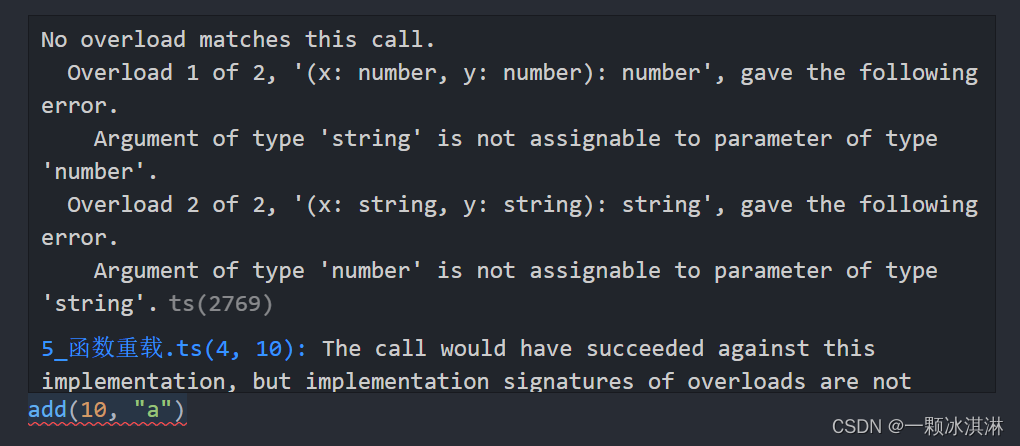
类
初始化
类中定义的变量需要初始化,可以在定义类的时候就赋值或者通过constructor来操作
class Person {
name: string;
age: number;
constructor(name: string, age: number) {
this.name = name;
this.age = age;
}
}
const person = new Person("alice", 20);
继承
ts和js中一致,都是通过 extends 实现继承,使用父级参数和方法时使用 super 关键字。
class Person {
name: string;
age: number;
constructor(name: string, age: number) {
this.name = name;
this.age = age;
}
}
class Student extends Person {
sno: number;
constructor(name: string, age: number, sno: number) {
super(name, age);
this.sno = sno;
}
}
const student = new Student("alice", 20, 1);
多态
使用多态可以写出更加具备通用性的代码,如果想要实现多态首先得有继承,并且父类引用指向子类对象。
class Animal {
action() {
console.log("animal action");
}
}
class Dog extends Animal {
action() {
console.log("dog running");
}
}
class Fish extends Animal {
action() {
console.log("fish swimming");
}
}
function doAction(animals: Animal[]) {
animals.forEach((animal) => {
animal.action();
});
}
doAction([new Dog()]);
doAction([new Dog(), new Fish()]);
doAction([new Dog(), new Fish(), new Animal()]);
这里相当于 const animal1: Animal = new Dog() ,看起来是 Animal 对象,其实是 Dog 对象,这里的父类引用指向的是子类对象,所以最后执行的是 Dog 对象的方法

成员修饰符
成员修饰符有以下三种
- public 表示共有的,任何地方都可见,当没有定义成员修饰符时,默认为public
- private 私有的,只有类中能够访问到
- protected 被保护的,表示类自身和子类可以访问到
public
class Person {
public username: string = "alice";
getName() {
return this.username;
}
}
const person = new Person();
console.log(person.username);
private
通过private修饰的变量,在实例对象上也是不可访问的。
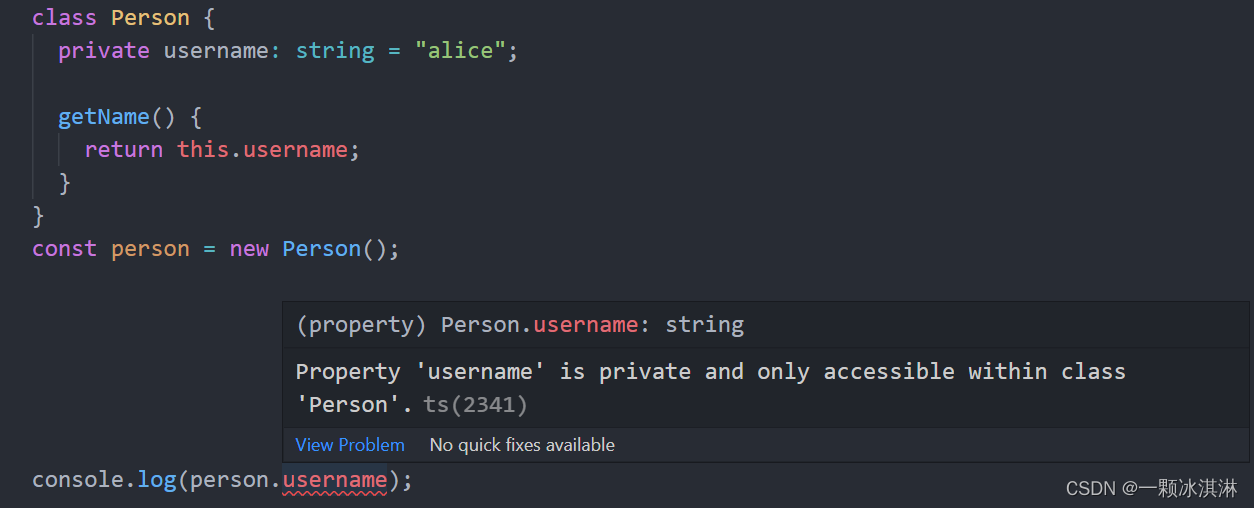
protected
通过protected修饰的变量,在实例对象上也是不可访问的。
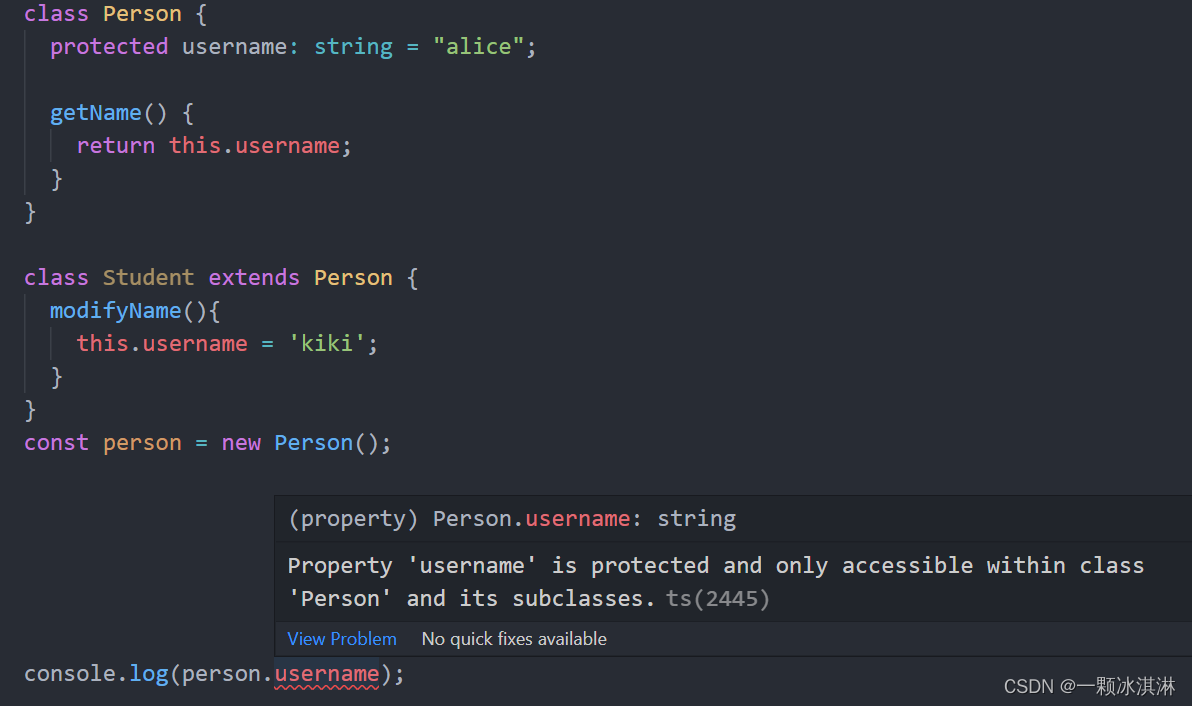
readonly
readonly表示该属性只读,初始化了之后就不能以任何方式修改,无论是在类内部,还是修改实例对象,但当它是一个对象时,只要不改变它的内存地址,修改对象的属性是可以的。
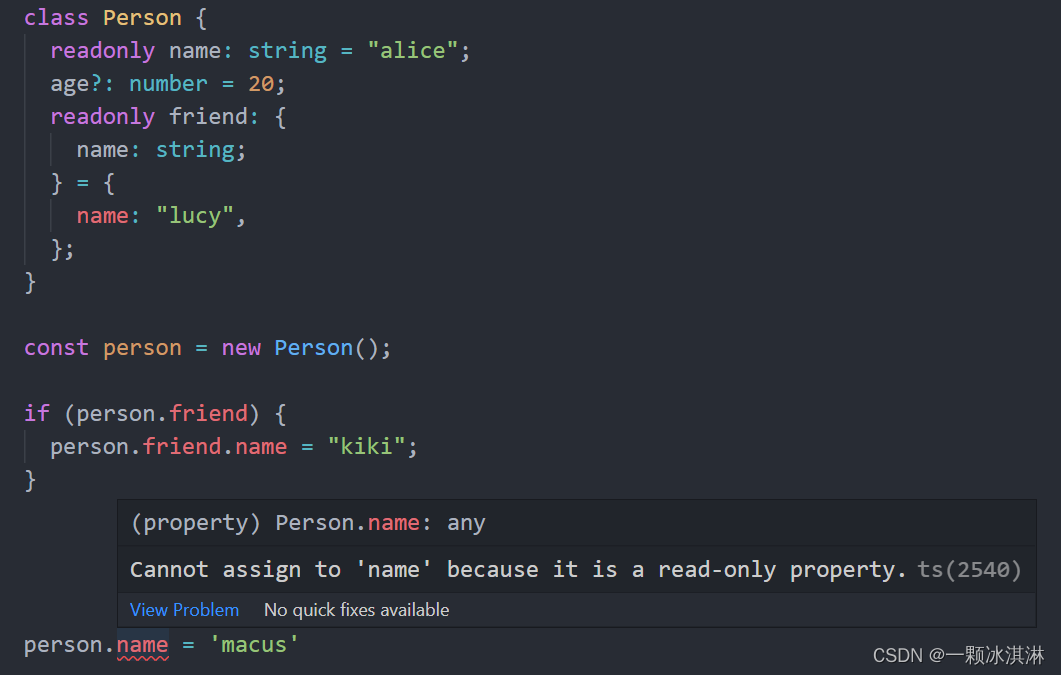
访问器
访问器给私有属性提供get/set方法,让我们在类外部获取/修改私有属性
class Person {
private _name: string;
constructor(newName: string) {
this._name = newName;
}
get name() {
return this._name;
}
set name(newName) {
if (newName) this._name = newName;
}
}
const person = new Person("alice");
console.log(person.name);
person.name = "kiki";
console.log(person.name);
person.name = "";
console.log(person.name);
通过get/set属性来修改私有属性可以做到拦截/判断的作用

静态成员
静态成员通过 static 关键字来定义,通过 static 定义的属性,是定义在类自身的,只能通过自己访问,在类内部和实例对象都是无法访问到的。
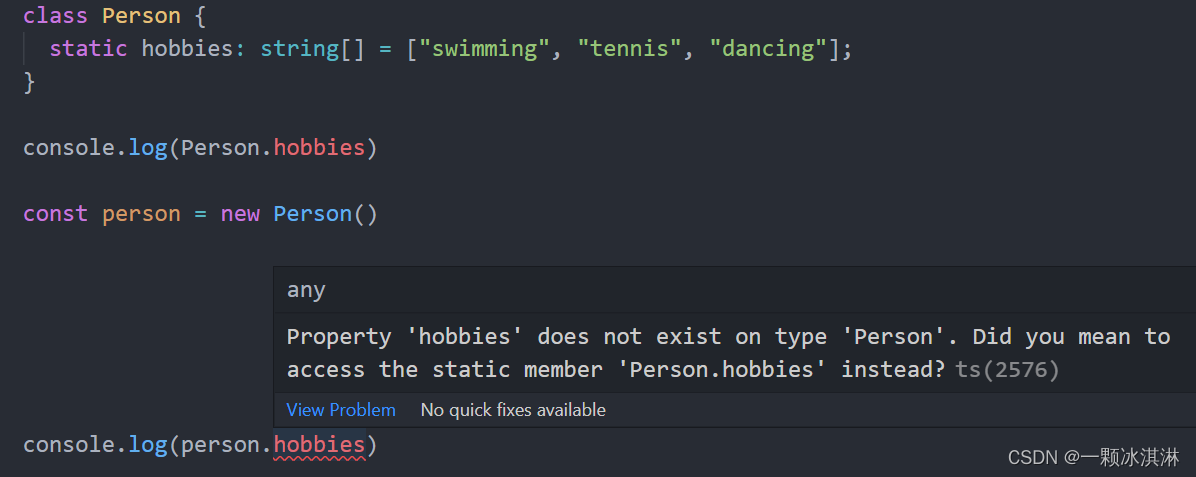
抽象类
在定义很多通用的调用接口时,我们通常会让调用者传入父类,通过多态来实现更加灵活的调用方式。
但是,父类本身可能并不需要对某些方法进行具体的实现,所以父类中定义的方法, 我们可以定义为抽象方法。
abstract class Shape {
abstract getArea(): void;
}
class Circle extends Shape {
private radius: number;
constructor(radius: number) {
super();
this.radius = radius;
}
getArea() {
return this.radius * this.radius * 3.14;
}
}
class Rectangle extends Shape {
private width: number;
private height: number;
constructor(width: number, height: number) {
super();
this.width = width;
this.height = height;
}
getArea() {
return this.width * this.height;
}
}
function calcArea(shape: Shape) {
return shape.getArea();
}
console.log(calcArea(new Circle(3)));
console.log(calcArea(new Rectangle(2, 6)));
抽象方法和方法通过 abstract 来修饰,并且抽象类定义时有两条规则:
- 抽象方法必须要在子类实现
- 抽象类是不能被实例化的

类的类型
类本身也是可以作为一种数据类型的,可以用作类型注解。
class Person {
name: string = "alice";
eating() {}
}
const person: Person = {
name: "kiki",
eating() {
console.log("i am eating");
},
};
function printPerson(person: Person) {
console.log(person.name);
}
printPerson(new Person());
printPerson(person);
printPerson({ name: "macsu", eating() {} });
只要符合类的格式,就可以使用类的类型
函数和类在JS和TS中都是至关重要的,可以帮助开发者更好规范开发时的代码,减少线上故障~
总结
以上就是关于TypeScript函数和类的内容,希望能够给你带来帮助,也希望您能够多多关注的更多内容!
加载全部内容